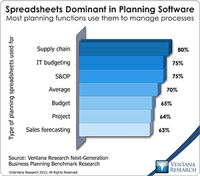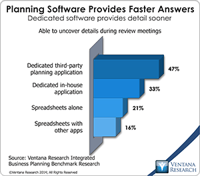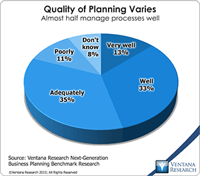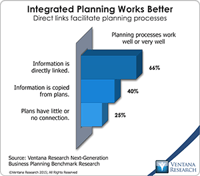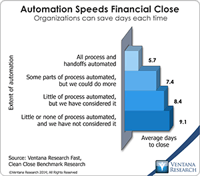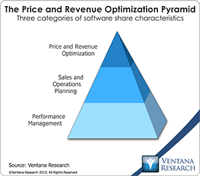Supply and demand chain planning and execution have grown in importance over the past decade as companies have recognized that software can meaningfully enhance their competitiveness and improve their financial performance. Sales and operations planning (S&OP) is an integrated business management process first developed in the 1980s aimed at achieving better alignment and synchronization between the supply chain, production and sales functions. A properly implemented S&OP process routinely...
Read More
Topics:
Planning,
SaaS,
Sales,
Sales Performance,
Supply Chain Performance,
Forecast,
Human Capital,
Mobile Technology,
Supply Chain Planning,
Operational Performance,
Analytics,
Business Analytics,
Business Collaboration,
Business Performance,
Cloud Computing,
Financial Performance,
Sales Performance Management (SPM),
Sales Planning,
Supply Chain,
Demand Chain,
Integrated Business Planning,
SCM Demand Planning,
S&OP
Adaptive Insights held its annual user group meeting recently. A theme sounded in several keynote sessions was the importance of finance departments playing a more strategic role in their companies. Some participating customers described how they have evolved their planning process from being designed mainly to meet the needs of the finance department into a useful tool for managing the entire business. Their path took them from doing basic financial budgeting to planning focused on improving...
Read More
Topics:
Planning,
Predictive Analytics,
Human Capital,
Marketing,
Reporting,
Sales Forecasting,
Budgeting,
Customer Performance,
Operational Performance,
Analytics,
Business Analytics,
Business Collaboration,
Business Performance,
Financial Performance,
Business Planning,
Supply Chain,
Demand Planning,
Integrated Business Planning,
Project Planning
It’s stating the obvious to say that how well executives manage planning processes has a big impact on how well a business unit or company plans. However, one significant source of the value of our benchmark research is that it establishes hard evidence – the numbers – that transforms mere assertions into proof points. This is particularly important when people within an organization want to improve a process. Change management is facilitated by providing senior executives with facts to back up...
Read More
Topics:
Big Data,
Predictive Analytics,
Sales,
Sales Performance,
Supply Chain Performance,
Marketing,
Customer Performance,
Operational Performance,
Business Analytics,
Business Performance,
Cloud Computing,
Financial Performance,
Supply Chain,
S&OP
Ventana Research recently released the results of our Next-Generation Business Planning benchmark research. Business planning encompasses all of the forward-looking activities in which companies routinely engage. The research examined 11 of the most common types of enterprise planning: capital, demand, marketing, project, sales and operations, strategic, supply chain and workforce planning, as well as sales forecasting and corporate and IT budgeting. We also aggregated the results to draw...
Read More
Topics:
Big Data,
Planning,
Predictive Analytics,
Sales,
Sales Performance,
Social Media,
Supply Chain Performance,
Human Capital Management,
Marketing,
Office of Finance,
Reporting,
Budgeting,
Controller,
Customer Performance,
Operational Performance,
Business Analytics,
Business Performance,
Cloud Computing,
Financial Performance,
In-memory,
Workforce Performance,
CFO,
Supply Chain,
capital spending,
demand management,
Financial Performance Management,
financial reporting,
FPM,
Integrated Business Planning,
S&OP
Business planning includes all of the forward-looking activities in which companies routinely engage. Companies do a great deal of planning. They plan sales and determine what and how they will produce products or deliver services. They plan the head count they’ll need and how to organize distribution and their supply chain. They also produce a budget, which is a financial plan. The purpose of planning is to be successful. Planning is defined as the process of creating a detailed formulation of...
Read More
Topics:
Big Data,
Planning,
Predictive Analytics,
Sales Performance,
Supply Chain Performance,
Human Capital,
Marketing,
Office of Finance,
Reporting,
Sales Forecasting,
Budgeting,
Operational Performance,
Analytics,
Business Analytics,
Business Collaboration,
Business Performance,
Customer & Contact Center,
Financial Performance,
Business Planning,
Supply Chain,
Demand Planning,
Integrated Business Planning,
Project Planning,
S&OP
SYSPRO is a 35-year-old ERP vendor that focuses on products for midsize companies, particularly those in manufacturing and distribution. In manufacturing, SYSPRO supports make, configure and assemble, engineer to order, make to stock and job shop environments. The company attempts to differentiate itself through vertical specialization and its years of ongoing development, which can reduce the need for customization and cut the cost of initial and ongoing configuration to suit the needs of...
Read More
Topics:
Performance Management,
Supply Chain Performance,
ERP,
Human Capital Management,
Office of Finance,
Reporting,
cloud ERP,
container,
Operational Performance,
Analytics,
Business Analytics,
Business Performance,
Cloud Computing,
Collaboration,
Dashboards,
Financial Performance,
Supply Chain,
SCM,
S&OP,
Digital Technology
A core objective of my research practice and agenda is to help the Office of Finance improve its performance by better utilizing information technology. As we kick off 2014, I see five initiatives that CFOs and controllers should adopt to improve their execution of core finance functions and free up time to concentrate on increasing their department’s strategic value. Finance organizations – especially those that need to improve performance – usually find it difficult to find the resources to...
Read More
Topics:
Big Data,
Performance Management,
Planning,
Predictive Analytics,
Sales Performance,
Supply Chain Performance,
Office of Finance,
Budgeting,
close,
dashboard,
PRO,
Tax,
Analytics,
Business Analytics,
Business Collaboration,
Business Performance,
CIO,
Customer & Contact Center,
Financial Performance,
In-memory,
CFO,
Supply Chain,
CEO,
demand management,
Financial Performance Management,
FPM,
S&OP
The need to be effective in the marketing, selling, manufacturing, distributing, and sourcing products requires more consistent and higher quality product information. This is where product information management (PIM) has great potential, and as I have attested is the responsibility of business to lead the process and technology improvements. Of course for PIM to be efficient IT needs to support business leadership to improve PIM and ensure access and integration of data and applications. One...
Read More
Topics:
Big Data,
Sales,
Sales Performance,
Supply Chain Performance,
Operational Performance,
Customer & Contact Center,
Information Applications,
Information Management,
Commerce,
Product Information Management,
Supply Chain
People who don’t spend much time analyzing the software market may have trouble understanding the differences between products in a given software category or the difference between two categories. This happens because vendors and commentators use the same words to describe different depths of functionality and degrees of comprehensiveness in one type of application. As well, there can be multiple categories of software that address the same general business issues but are designed for...
Read More
Topics:
Performance Management,
Sales Performance,
Supply Chain Performance,
Office of Finance,
dashboard,
PRO,
Operational Performance,
Business Analytics,
Business Performance,
Financial Performance,
CFO,
Supply Chain,
CEO,
demand management,
FPM,
S&OP
Infor described this year’s Inforum user group meeting as a coming-out party for a large startup company. Such a debut was necessary because Infor had been operating in something of a stealth mode for the past three years: a limited marketing presence, no unified message and a weak, sometimes inconsistent brand identity. It also needed to formally introduce Infor to customers of Lawson, the ERP supplier it acquired last year. The “startup” designation is meant to signal that Infor has been able...
Read More
Topics:
Performance Management,
Sales Performance,
Salesforce.com,
SAP,
Social Media,
Supply Chain Performance,
Sustainability,
ERP,
Human Capital Management,
Marketing,
Epiphany,
expense management,
Lawson,
IT Performance,
Operational Performance,
Business Analytics,
Business Collaboration,
Business Intelligence,
Business Mobility,
Cloud Computing,
Customer & Contact Center,
Financial Performance,
Governance, Risk & Compliance (GRC),
IBM,
Information Applications,
Information Management,
Location Intelligence,
Operational Intelligence,
Oracle,
Workforce Performance,
CRM,
finance,
Infor,
Supply Chain,
Financial Performance Management
